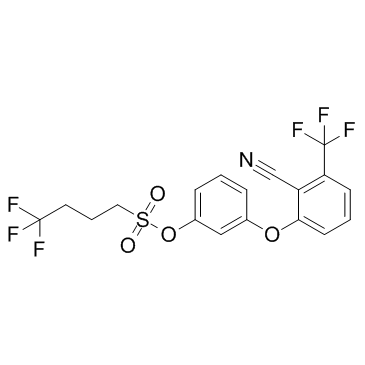Bay 59-3074
Modify Date: 2025-08-24 22:43:30

Bay 59-3074 structure
|
Common Name | Bay 59-3074 | ||
|---|---|---|---|---|
| CAS Number | 406205-74-1 | Molecular Weight | 453.35600 | |
| Density | 1.496g/cm3 | Boiling Point | 490.569ºC at 760 mmHg | |
| Molecular Formula | C18H13F6NO4S | Melting Point | N/A | |
| MSDS | N/A | Flash Point | 250.488ºC | |
Use of Bay 59-3074Bay 59-3074 is a novel, selective CB1/CB2 receptor partial agonist with Ki values of 48.3 and 45.5 nM at human CB1 and CB2 receptors respectively . Orally active CB1 agonist in vivo. target: CB1/CB2 receptor partial agonist.Ki: 48.3 and 45.5 nM (CB1 and CB2 receptors)In vitro: analgesic, antihyperalgesic, and antiallodynic properties in rat models of acute and chronic pain. The reference concentration is 10 μM. [1]In vivo: administration of BAY 59-3074 (ED50 value: 0.41 mg/kg).Orally active CB1 agonist in vivo. [2] BAY 59-3074 (0.3-3 mg/kg, p.o.) induce antihyperalgesic and antiallodynic effects against thermal or mechanical stimuli in rat models of chronic neuropathic. Antiallodynic efficacy of BAY 59-3074 (1 mg/kg, p.o.) in the spared nerve injury model was maintained after 2 weeks of daily administration. However, tolerance developed rapidly (within 5 days) for cannabinoid-related side effect. [1] BAY 59-3074 have analgesic, antihyperalgesic, and antiallodynic properties in rat models of acute and chronic pain.[1] |
| Name | [3-[2-cyano-3-(trifluoromethyl)phenoxy]phenyl] 4,4,4-trifluorobutane-1-sulfonate |
|---|---|
| Synonym | More Synonyms |
| Description | Bay 59-3074 is a novel, selective CB1/CB2 receptor partial agonist with Ki values of 48.3 and 45.5 nM at human CB1 and CB2 receptors respectively . Orally active CB1 agonist in vivo. target: CB1/CB2 receptor partial agonist.Ki: 48.3 and 45.5 nM (CB1 and CB2 receptors)In vitro: analgesic, antihyperalgesic, and antiallodynic properties in rat models of acute and chronic pain. The reference concentration is 10 μM. [1]In vivo: administration of BAY 59-3074 (ED50 value: 0.41 mg/kg).Orally active CB1 agonist in vivo. [2] BAY 59-3074 (0.3-3 mg/kg, p.o.) induce antihyperalgesic and antiallodynic effects against thermal or mechanical stimuli in rat models of chronic neuropathic. Antiallodynic efficacy of BAY 59-3074 (1 mg/kg, p.o.) in the spared nerve injury model was maintained after 2 weeks of daily administration. However, tolerance developed rapidly (within 5 days) for cannabinoid-related side effect. [1] BAY 59-3074 have analgesic, antihyperalgesic, and antiallodynic properties in rat models of acute and chronic pain.[1] |
|---|---|
| Related Catalog | |
| References |
| Density | 1.496g/cm3 |
|---|---|
| Boiling Point | 490.569ºC at 760 mmHg |
| Molecular Formula | C18H13F6NO4S |
| Molecular Weight | 453.35600 |
| Flash Point | 250.488ºC |
| Exact Mass | 453.04700 |
| PSA | 84.77000 |
| LogP | 6.50128 |
| Index of Refraction | 1.521 |
| InChIKey | LWUSZIVDPJPVBW-UHFFFAOYSA-N |
| SMILES | N#Cc1c(Oc2cccc(OS(=O)(=O)CCCC(F)(F)F)c2)cccc1C(F)(F)F |
| Storage condition | 2-8℃ |
| bay 59-3074 |
| hms3269k19 |
| unii-5fo5z101gu |